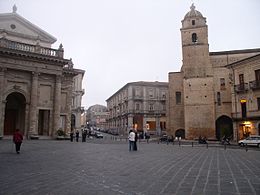Eucharistic miracle of Lanciano

The Miracle of Lanciano dates back to the eighth century when a monk who had doubts about the Real presence of Jesus Christ in the Eucharist, found when he said the words of consecration at Mass, that the bread and wine changed into flesh and blood. It has been certified by the Catholic Church as a Eucharistic miracle.
Today the miracle is in the Church of San Francesco in Piazza Plebiscito. Lanciano has a population of 36,305 as of 2011.
History
According to Richmond's ancient accounts, in the city of Lanciano, Italy, then known as Anxanum, around 700, a Basilian hieromonk was assigned to celebrate Mass at the monastery of St. Longinus. Celebrating in the Latin Rite and using unleavened bread, the monk had doubts about the Real Presence of Jesus Christ in the Holy Eucharist.[1]

During the Mass, when he said the Words of Consecration ("This is my body. This is my blood"), with doubt in his soul, the priest is said to have seen the bread change into living flesh and the wine change into blood[1] which coagulated into five globules, irregular and differing in shape and size (the number supposed to be correspondent to the number of wounds Christ suffered on the cross: one in each hand and foot from the nails, and the wound from the centurion's spear).
People who believed they had witnessed the miracle soon spread the news throughout the surrounding area, and the archbishop ordered an investigation. Church authorities certified the miracle.[1] Since 1713 the Host-Flesh has been reserved in an artistic silver Ostensorium.
Investigations

Since 1574, various investigations of varying degrees of detail have been conducted upon the elements:
- February 17, 1574 by Msgr. Antonio Gaspar Rodríguez
- 1636 by Father Serafino from Scanno
- October 23, 1777 by Bishop Gervasone
- October 26, 1886 by Bishop Petrarca
- 1971 and 1981, by Odoardo Linoli
Linoli's examination
The examination[2] in 1971 was performed by Odoardo Linoli, a professor in anatomy and pathological histology as well as chemistry and clinical microscopy, and former head of the Laboratory of Pathological Anatomy at the Hospital of Arezzo.[3] He was assisted by Ruggero Bertelli, a retired professor of human anatomy at the University of Siena. The report was published in Quaderni Sclavo di Diagnostica Clinica e di Laboratori in 1971.[3][4]
Linoli's released his findings in March 1971. According to his study, the flesh is human cardiac tissue. He said he found proteins in the blood, in the same normal proportions (percentage-wise) as are found in the sero-proteic make-up of fresh normal blood. Linoli found no trace of preservatives.[5]
Current status
The Basilian monks kept custody of the elements until their departure in 1175. They were succeeded by Benedictine monks in 1176. The items were placed in different locations within the Church of St. Francis at Lanciano. They were kept in the Valsecca Chapel from 1636 until 1902 when they were relocated to a new altar.
When he was Cardinal of Kraków, Pope John Paul II visited the Church of St Francis in Lanciano.[6]
The elements can still be seen today. The flesh, which is the same size as the large host used in the Latin Church, is fibrous and light brown in color and becomes rose-colored when lighted from the back. The blood consists of five coagulated globules and has an earthy color resembling the yellow of ochre.
Pictures and documents
-
Rear-lighted panel (side)
-
Rear-lighted panel (front)
-
Scientific recognition (18 November 1970)
-
Scientific recognition (4 March 1971)
-
Document by Prof. Ruggero Bertelli
-
Related article in L'Osservatore Romano
-
Places with similar miracles
Notes
- ^ a b c Saunders, William. The Miracle of Lanciano, "Straight Answers", Arlington Catholic Herald, September 7, 2000
- ^ "fullreport". Retrieved 2009-05-29.
{{cite web}}:|archive-url=is malformed: timestamp (help); Unknown parameter|deadurl=ignored (|url-status=suggested) (help) - ^ a b "Physician Tells of Eucharistic Miracle of Lanciano". Retrieved 2011-01-06.
- ^ Linoli, O. "Histological, immunological and biochemical studies on the flesh and blood of the eucharistic miracle of Lanciano (8th century)"
- ^ Nasuti OFM Conv, Nicola. "The Eucharistic Miracle of Lanciano:Historical, Theological, Scientific and Photographic Documentation
- ^ Pope John Paul II, "Letter To Archbishop Carlo Ghidelli Of Lanciano-Ortona (Italy)", October 4, 2004, Vatican








